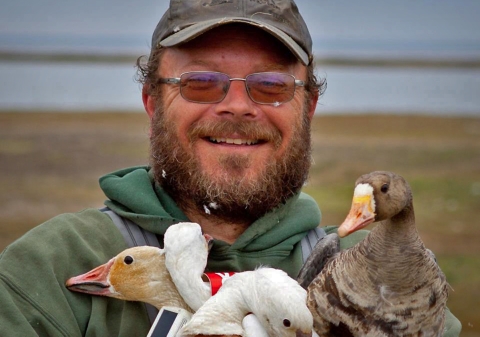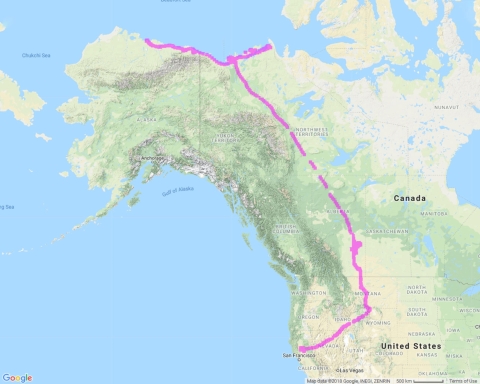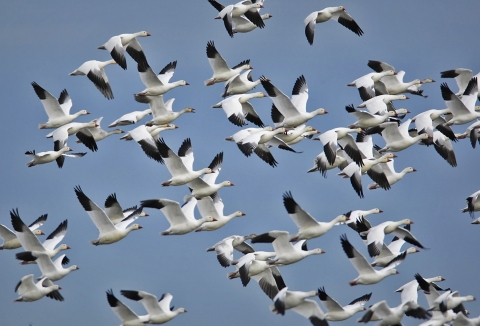Chris Nicolai’s serendipitous experience with a snow goose is sort of like the classic film Fly Away Home, but in real life.
Chris Nicolai, waterfowl biologist, holding collared snow geese in Alaska. Photo courtesy of Chris Nicolai.
The 1996 movie dramatized the actual experiences of Bill Lishman who, in 1986, started training Canada geese to follow his ultralight aircraft. He later succeeded in leading their migration in 1993 through his program "Operation Migration." Nicolai, a waterfowl biologist for the U.S. Fish and Wildlife Service in Reno, Nevada, has been a waterfowl fanatic since he was old enough to ride a bike. By the time he was in his early teens, he had seen every single waterfowl species native to North America. Now he is conserving migratory birds full-time, and after banding a mottled duck in Louisiana in June 2018, Nicolai can officially say he has trapped and banded every native waterfowl species on the continent.
After achieving this latest personal record in the bird world, Nicolai took a trip to the Colville River Delta, 60 miles west of PrudHoe Bay, in the Arctic Circle region of northern Alaska, to mark snow geese. He participated in part of one of the newest and largest waterfowl research projects in North America that focuses on how migratory birds use habitat throughout the Pacific flyway.
Specifically, the research marks several goose populations with tracking devices. The marking is done in breeding areas in northern breeding habitat and in wintering areas in California.
“By marking geese in the winter, we can learn which areas they use for breeding and identify new breeding areas up north,” Nicolai said. “Alternatively, by marking geese in already known breeding areas up north, we can learn where geese spend the winter.”
“Regardless of where the geese are marked, we will learn more about their migration routes,” he said. ”We hope to better understand where they travel between breeding and overwintering and the wetlands they rely on for sleeping and feeding during this time.”
This map shows the 2,500-mile flight path of the snow goose that Chris Nicolai banded and fitted with a GPS collar, from Alaska to California, including an over-flight of Reno, Nevada. Credit: Chris Nicolai/USFWS
The project tracks waterfowl along the Pacific Flyway using radios with cell phone technology. Each bird takes a unique path when traveling to its final destination in the southern United States or northern Mexico, but they all follow the same general pattern flying through Canada and the western United States.
At the Colville River Delta, Nicolai marked 15 snow geese before the birds set out to fly south. Once the radios are delicately placed around the bird’s neck, any subsequent movement is instantly transmitted to an online database.
Since returning to Reno, Nicolai has made it part of his daily routine to check on the status of these radioed birds as they move south. He’s able to see new information each day because these state-of-the-art radio devices track migration in real-time and provide data on the bird’s location every 20 minutes.
“Every year snow geese fly over my house in Reno during fall migration,” he said. Nicolai knows this because he hears their calls as they pass through in the dark. But this year, he didn’t just hear their calls.
Like any other day, Nicolai checked the tracking system to look at the current locations of the marked geese. He did a double take. One of the geese that Nicolai banded in Alaska had flown through Reno. He zoomed in on the map.
Not only had it flown over Reno, but it flew along the northern edge of town, almost directly over Nicolai’s house at 4:30 a.m.
“I banded a bird in Alaska that literally flew over my house and my garage, where I keep of all my banding and radio equipment,” he said. “I knew that migratory snow geese passed through northern Nevada near Reno, but I was elated to have one that I collared fly right over my neighborhood. It's almost like the bird was passing through to let me know the migration was going well.”
Filling the sky: Snow and Ross's geese pass over the Sacramento National Wildlife Refuge. Credit: Steve Emmons/USFWS
By Joanna Gilkeson, Reno Fish and Wildlife Office





